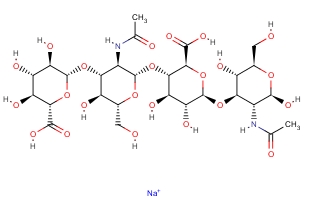|
1.Discovery of HA:In 1934, Karl Meyer isolated a
formerly unknown glycosaminoglycan from the vitreous humor of the bovine eye. It
differed from any of the other previously discovered glycosamlnoglycans in that
it did not contain sulffur. With its distinctive structure, its function within
the body was unique. It was named hyaluronan and further scientific study
ensued. At the time of its discovery, the new compound took on two names:
hyaluronan when referring to its endogenous synthesis and hyaluronic acid when
discussing research conducted outside of the body-huma or animal. Today
hyaluronan is comonly referred to as hyaluronic acid, regardless of the context
in which it is spoken.
2.Structure of HA:Hyaluronic
Acid is linear, unbranched, high molecular weight polysaccharides containing a
repeating disaccharide unit (D-glucuronic acid and N-acetyl glucosamine). HA, in
its natural state, weighs about from 0.5-3.0 million daltons. Its weight lends
itself to high viscosity and excellent lubrication within the body. The other
glycosaminoglcans in the body include chondroitin sulfate, keratan sulfate,
dermatan sulfate, and heparin sulfate.
3. Distribution of
HA:HA widely consists in the extracelluar spaces of animal tissue.
Almost kinds of animal tissue contain the different quantity of HA. Today
Hyaluronic Acid has been found from skin, cockcomb, brain, vitreum, connective
tissue, umbilical cord, human serum, articular fluid, gristle, human urine, cock
embryo, oocyte, artery and vein etc.
Structural Formula:

|




